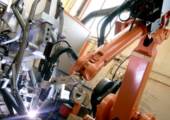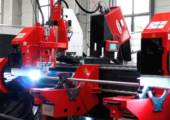-


在线留言
发送您的问题或需求,我们将尽快与您取得联系!
×
-
POWER SOURCE MANUFACTURERS ARE
CHANGING THEIR FOCUS
07/27/2020
The global march of digitisation and interconnectivity – known as “Industry 4.0” – is making production processes faster, more transparent and more reliable from the ground up, allowing even small batch sizes to be manufactured cost-effectively. Welding fabrication plays a significant role here: new functions and capabilities are in demand for the optimum integration of welding systems into the interconnected and computer-controlled factories of the future. HARALD SCHERLEITNER, Global Director Sales & Marketing Business Unit Perfect Welding, explains the specific issues faced by welding technology manufacturers and the outlook for current and future solutions in the industry.

Mr Scherleitner, the term “Industry 4.0” is rarely encountered in the field of welding technology. What do you understand by this term?
Industry 4.0 stands for the digitisation and interconnection of industrial production, one of the most important topics of our time. Digitisation has already become the norm in our private lives – take, for example, social networks, e-commerce or comparison portals for hotels and flights. Now it is a matter of applying the benefits that we associate with these platforms to industry: in a similar manner to the hotel booking portal, which compares offers and determines the cheapest prices, companies can submit a request to a “component production portal”. This sends all information regarding the supply chain, capacity utilisation and production dates directly to the production department, so that the desired components can be manufactured and delivered immediately. The opportunities that digitisation brings are immense – from increases in internal efficiency to the introduction of completely new business models.
What challenges is the welding technology sector facing in connection with Industry 4.0?
Power source manufacturers are changing their focus: while the conversion of electricity had for decades been the key to success, it is now the digitisation of the welding process. In the future, communication, real-time data control, data storage, cyber security and intelligent man-machine interfaces will be the driving forces of R&D. For example, software tools that optimise welding parameters or manage wearing parts will play a more dominant role. Hardware will no longer be as relevant; however, fault-free functioning will remain an essential prerequisite.
Will the demands on welding systems change significantly as a result?
This is already happening: the power source of the future is a high-end computer with a powerful microprocessor and intelligent software. However, the quality of the electronic components must not be overlooked. Production technologies must adapt quickly and efficiently to a wide range of requirements, which also applies to modern welding systems. Easy operation, straightforward system configurations, quick connection and incorporation into automated systems, and the production of consistently high quality are all factors.
What is Fronius' focus with regard to the topic of digitisation?
Digital transformation is a fixed component of our corporate strategy, which is why we are intensively developing and honing our systems to make them even better. We launched the first fully digitised power source onto the market way back in 1998, and just a few years later we had already begun developing the next generation: the TPS/i, which has been available since 2013. Other innovations, such as the WeldCube or Virtual Welding simulator, are also fully in keeping with the digital age.
What particular challenges are you setting for yourselves?
The difficult thing about developing innovations is that although you start with a vision, you have yet to formulate a specific plan with which to implement it. For this reason, we are working intensively with various research institutes. Of course, Industry 4.0 also presents challenges for us as a company, and we must adapt our internal structures and work with new tools. One such example is our new Product Life Cycle Management (PLM) system for the comprehensive management of all product data and processes, right through from R&D and manufacture to sales and maintenance. We aim to harness the opportunities that digitisation brings to make our own processes more efficient and to identify new business models, such as in software management.
The key aspect of digitisation is the generation and processing of data. What impact is this having on your industry?
I could not agree more with the statement that “data is the raw material of the 21st century”. To generate and use data efficiently, you need new sensor technology, extremely fast transmission technology, open interfaces for importing component-specific data and combining it with process-relevant welding data, and of course intelligent analysis functions. We can use the data collected to monitor, evaluate, document and, where necessary, correct welding processes in real time. The corresponding software must be low maintenance and easy to integrate into production systems, and ideally it should be possible to bring together all power source data from across an entire company. We have also taken these aspirations into account in the development of our WeldCube solution.
Increased interconnectivity is another significant feature of Industry 4.0. How do you rate the sharing of data beyond company boundaries?
The deciding factor here is that the shared data cannot be accessed by unauthorised persons – and is thus protected against prying eyes. By way of example, Fronius has developed a special system for the TPS/i that protects internal communications according to its own extremely high standard. Of course, many of our customers want their data to remain confidential, and we respect that. However, digitisation does also require some degree of openness. Companies must exchange information with one another and pool their expertise in order to overcome increasingly complex challenges.
How do your customers benefit from increasing digitisation and interconnectivity?
There are a whole host of benefits for our customers. Quick data recording and processing allows for new, future-proof process variants such as LSC and PMC, as well as additional functions such as the arc length and penetration stabilizers. Servicing is also quicker and easier: for example, our “FeeL Remote Support” permits remote access to a TPS/i power source for fault diagnosis and repair, data analysis or process optimisation. Of course, there are also users that have only limited use for the information in this data flow, and in this event, we strive to support our customers in accordance with their individual needs.
What is the outlook regarding the further development of welding technology?
The goal of Industry 4.0 is, among other things, to establish autonomous production cells. In terms of the welding process, this means that a computer determines the weld seam geometries and layer structure, and selects, checks and controls the welding parameters independently. This results in a “Smart Factory”, in which manufacturing and logistics systems can organise themselves to a large extent and components are only manufactured as required. Companies can accommodate the trend towards customised products, increase their efficiency and reduce costs. In light of this, generative production methods are becoming increasingly important, in which the arc also plays a significant role. Our CMT welding process can form the basis for the efficient manufacturing of metallic 3D geometries, and Virtual Welding will also become an essential tool in the future – not just for training purposes, but above all to gain an impression of the “welding reality” in advance.
Will welding ever be possible without humans?
This vision will not become a full reality for the next few decades at least, considering that the digitisation of a welding technologist's wealth of expertise alone poses an enormous challenge. Our current focus is on making the welding process easier to control so that errorfree welding is possible.
PROFILE IN BRIEF
In 1994, Harald Scherleitner (38) started out at Fronius as an electromechanics apprentice. He later went on to work at subsidiaries in Mexico and Brazil. After eight years as the head of the Business Unit Perfect Charging, Scherleitner became head of the Fronius Business Unit Perfect Welding in the summer of 2016.
-


 下载
下载
 会员中心
会员中心



 收起
收起























